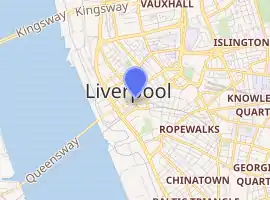Bank of England Building, Liverpool
The Bank of England Building is a Grade I listed building located in Liverpool, England.
| Bank of England Building | |
|---|---|
 | |

| |
| General information | |
| Architectural style | Neoclassical |
| Location | 31 Castle Street |
| Town or city | Liverpool |
| Country | |
| Construction started | 1845 |
| Completed | 1848 |
| Client | Bank of England |
| Design and construction | |
| Architect | Charles Robert Cockerell |
Listed Building – Grade I | |
| Designated | 28 June 1952 |
| Reference no. | 1205904[1] |
History
The Bank of England first decided to open premises on Castle Street, Liverpool in 1826, which helped established the area as the city's financial centre.[2]
The present building was designed by Charles Robert Cockerell and built in a Neoclassical style between 1845 and 1848.[3] The building was constructed as one of three branch banks for the Bank of England in the mid-19th century.[4]
The building was used entirely by the bank and did not contain any lettable space to other businesses, which were being fast established in the district. Subsequently Cockerell built a similar building in Cook Street for this purpose. It was demolished in 1959.[2]
Architecture
The building combines several neoclassical architectural styles, including Greek, Roman and Renaissance. The most evident of these is Greek, with four Doric style columns 'tying' the ground and first floors together.[5] The building itself is raised up from ground level, sitting atop a rough granite plinth.[4]
The front of the building held accommodation for the bank's agent, accessible from Union Court. The sub-agent had a similar layout at the rear.[2]
Despite only being three bays wide and seven bays deep, the building's design was seen to give it an "overwhelmingly massive and powerful" appearance.[5] The building is regarded as one of Cockerell's most impressive and was described by Nikolaus Pevsner as a "masterpiece of Victorian architecture".[5] and by the National Heritage List for England as "one of Cockerell's richest and most inventive buildings." It was Grade I listed on 28 June 1952.[1]
See also
References
- Historic England. "Bank of England (1205904)". National Heritage List for England. Retrieved 9 May 2018.
- Built on Commerce - Liverpool's Central Business District. English Heritage (Report). pp. 36, 39. Retrieved 11 March 2020.
- Hughes, Quentin (1999). Liverpool: City of Architecture. Bluecoat Press.
- Liverpool City Council (2005). Maritime Mercantile City Liverpool. Liverpool University Press.
- Sharples, Joseph (2004). Pevsner Architectural Guides: Liverpool. Yale University Press.
External links
 Media related to Bank of England, Liverpool at Wikimedia Commons
Media related to Bank of England, Liverpool at Wikimedia Commons- Bank of England on Viewfinder



